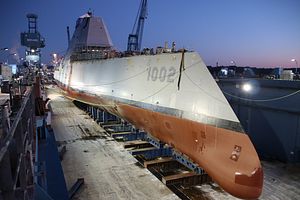The future USS Lyndon B. Johnson (DDG 1002), the third and final ship of the Zumwalt-class – the U.S. Navy’s largest and technologically most advanced class of guided-missile destroyers — was launched at the General Dynamics Bath Iron Works (BIW) shipyard in Maine on December 9, according to Naval Sea Systems Command.
“It’s important for the DDG 1000 program and shipyard to reach this major milestone,” said Captain Kevin Smith, the DDG 1000 program manager of Program Executive Office (PEO) ships, one of the U.S. Defense Department’s largest acquisition organizations. “With the first two ships of the class underway, we are excited to continue the next phase of construction of the future Lyndon B. Johnson.”
The third Zumwalt-class guided-missile destroyer was officially laid down in December 2017, although construction of the ship already kicked off in April 2012. In 2015, the U.S. Department of Defense briefly considered abandoning construction of the last Zumwalt-class as a cost saving measure. However, the plan to scrap the Lyndon B. Johnson was quickly abandoned after it became clear that cancelling the destroyer might end up costing the U.S. Navy more than continuing construction of the 16,000-ton warship.
The ship is expected to be christened in the spring. In comparison to its two sister ships, the USS Zumwalt and USS Michael Monsoor, the Johnson as a cost saving measure will feature a steel deckhouse instead of the composite structures of the other ships in the class. As I explained earlier this year:
Zumwalt-class destroyers feature distinct wave-piercing tumblehome hulls and a stealth design meant to reduce the ship’s radar cross-section. The destroyers are equipped with eighty MK57 vertical launch tubes, each capable of accommodating one to four missiles including SM-1, SM-2 and SM-6 missiles or Tomahawk land-attack missiles. The warships will also be armed with new long-range anti-ship missiles such as the Maritime Strike Tomahawk following a change of the mission requirements of the Zumwalt-class from a land-attack platform to surface warfare in November 2017. (The SM-6 surface-to-air missile can also be deployed as an anti-ship missile.)
Notably, the Zumwalt-class still does not have a suitable projectile for its two Advanced Gun Systems and is currently incapable of executing land-strike missions, which up until November 2017 was the Zumwalt-class’ primary mission requirement, as I explained previously:
With a cost of $800,000 to $1 million per Long Range Land Attack Projectile (LRLAP) round, the precision ammunition has become too expensive for the service. LRLAP is the only ammunition specifically designed to be fired by the USS Zumwalt’s two 155 millimeter/62-caliber Advanced Gun Systems (AGS), the main armament of the ship with an estimated range of up to 63 nautical miles (72 miles, 115 kilometers).
“The crew of Lyndon B. Johnson looks forward to bringing this great warship honoring our 36th President to life, and we’re proud to have the opportunity to be present for this important step in the ship’s construction,” said Captain Jeremy Gray, prospective commanding office of third Zumwalt-class guided missile destroyer. “It is truly impressive to see the ship afloat in the Kennebec River for the first time and we look forward to taking her to sea.”
































